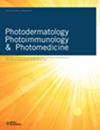Successful treatment of chronic actinic dermatitis with alitretinoin: Should retinoids be included in the therapeutical arsenal?
IF 2.5
4区 医学
Q2 DERMATOLOGY
Photodermatology, photoimmunology & photomedicine
Pub Date : 2023-09-01
Epub Date: 2023-05-18
DOI:10.1111/phpp.12888
引用次数: 0
Abstract
Chronic actinic dermatitis (CAD) is an infrequent and underdiagnosed photodermatosis mostly reported in adult men. There are still unmet therapeutic needs regarding this condition, forcing us to look for offlabel alternatives. A 62yearold construction worker came to our Contact Eczema and Immunoallergic Department with severe hyperkeratotic plaques in sunexposed areas. He had been suffering from chronic lesions on the dorsal side of his hands, knees, elbows, and upper back for 12 years that had progressively become lichenified (Figure 1). The condition drastically worsened over holiday periods, including an erythrodermic episode at the onset of the disease which happened over summer. He had been treating his disease with both topical and systemic corticosteroids on a regular basis since it first appeared. He had no other medical comorbidities and had repetitively been patch tested with negative results (European, acrylate, epoxy resin, and plant series— Chemotechnique Diagnostics) according to the criteria of the International Contact Dermatitis Research Group (ICDRG) on Day (D) 2, D4, and D7. Several skin biopsies were taken over time showing acanthosis, spongiosis, deep dermal lymphocytic infiltration (CD4:CD8 ratio was 1:1), lichenification, and prominent multinucleated dermal dendrocytes. None of the biopsies showed monoclonal gammaTcell receptor rearrangement. Photopatch test (including compositae mix and Sesquiterpene lactones) was negative. The photobiology study (Dermatologic Photobiology and DermatoOncology Laboratory, Photodiagnosis Unit, University of Málaga, Spain) elicited intense erythema to UVA (2 min, 44 J/cm2; PhoenixMH150 W/TD/NDL) and UVB (minimal erythema dose 9.3 mJ/cm2; dermalight 80UVB device [normal range: 25– 30 mJ/cm2 for his skin type: Fitzpatrick 2]), enabling the diagnosis of CAD. The patient started a hardening regimen with UVA1 phototherapy which had to be abruptly stopped due to excessive erythema and incoercible pruritus right after the sessions. Apart from strict solar protection, sun avoidance measures, topical corticosteroids, and emollients, we prescribed azathioprine 2 mg/kg a day. Unfortunately, this treatment had to be suspended within 1 month following severe hypertransaminasemia. Methotrexate 15 mg a week induced unbearable gastrointestinal side effects. Acitretin achieved some improvement with a dosage between 25 and 35 mg a day but after 2 months it was abandoned due to headaches that were uncontrollable with conventional analgesics. Alternatively, we prescribed alitretinoin 30 mg a day, providing significant symptomatic relief and improvement of his poikilodermatous appearance. Eight months after starting the treatment, the patient's condition had almost completely resolved (Figure 2), with no clinical or analytical side effects. NRS scale was 2 down from 10. Chronic actinic dermatitis consists of an immune reaction against elicited cutaneous antigens.1 This reaction induces inflammation of skin areas exposed to sunlight leading to a pruritic rash or eczema and, in the long term, to scaling and lichenification.2 In severe cases the reaction could be elicited with minimum exposure to light, heavily impacting quality of life in our patients. It is not rare to find it in the context of other dermatoses such as atopic dermatitis, photocontact3 or contact allergic dermatitis (fragrances, airborne particles, and plants like chrysanthemum...). Therefore, upon its diagnosis, it is important to rule out allergens and perform biopsies in order to differentiate from mycosis fungoides. The photobiology study is critical for enabling the diagnosis. Combined cutaneous sensitivity to UVB and UVA is the most commonly reported. Exclusive UVA photosensitivity is less frequent and should make us rule out a pharmacological origin of the photosensitivity. Nevertheless, it has recently been published that up to 18.2% of 488 patients show UVA reactivity exclusively.2 Its treatment is nothing short of challenging.4 Apart from sun avoidance measures, systemic immunosuppression is usually required. However, either due to low efficacy or side effects of these drugs, it is not unusual that we need to look at other unorthodox alternatives in such a chronic condition. Some authors have postulated benefits of treatments like PUVA therapy, thalidomide, azathioprine, cyclosporine, or even tofacitinib.5 Apart from these, in recent years, there have been different grades of improvement reported with dupilumab,6 alone or combined with methotrexate.7 This might be an alternative to consider for those patients with eczematous presentations and a CD4:CD8 ratio preserved, but it might not be as effective for every patient— CAD patients tend to show light or discrete increased CD8 populations outweighing the physiologic CD4 predominance in blood and peripheral tissues— . Alitretinoin (9cisretinoic acid) is a wellknown drug in Dermatology for which we are still finding阿利视黄醇成功治疗慢性光化性皮炎:类视黄醇是否应纳入治疗药物库?
本文章由计算机程序翻译,如有差异,请以英文原文为准。
求助全文
约1分钟内获得全文
求助全文
来源期刊
CiteScore
4.40
自引率
7.70%
发文量
85
审稿时长
6-12 weeks
期刊介绍:
The journal is a forum for new information about the direct and distant effects of electromagnetic radiation (ultraviolet, visible and infrared) mediated through skin. The divisions of the editorial board reflect areas of specific interest: aging, carcinogenesis, immunology, instrumentation and optics, lasers, photodynamic therapy, photosensitivity, pigmentation and therapy. Photodermatology, Photoimmunology & Photomedicine includes original articles, reviews, communications and editorials.
Original articles may include the investigation of experimental or pathological processes in humans or animals in vivo or the investigation of radiation effects in cells or tissues in vitro. Methodology need have no limitation; rather, it should be appropriate to the question addressed.
文献相关原料
| 公司名称 | 产品信息 | 采购帮参考价格 |
|---|

 求助内容:
求助内容: 应助结果提醒方式:
应助结果提醒方式:


